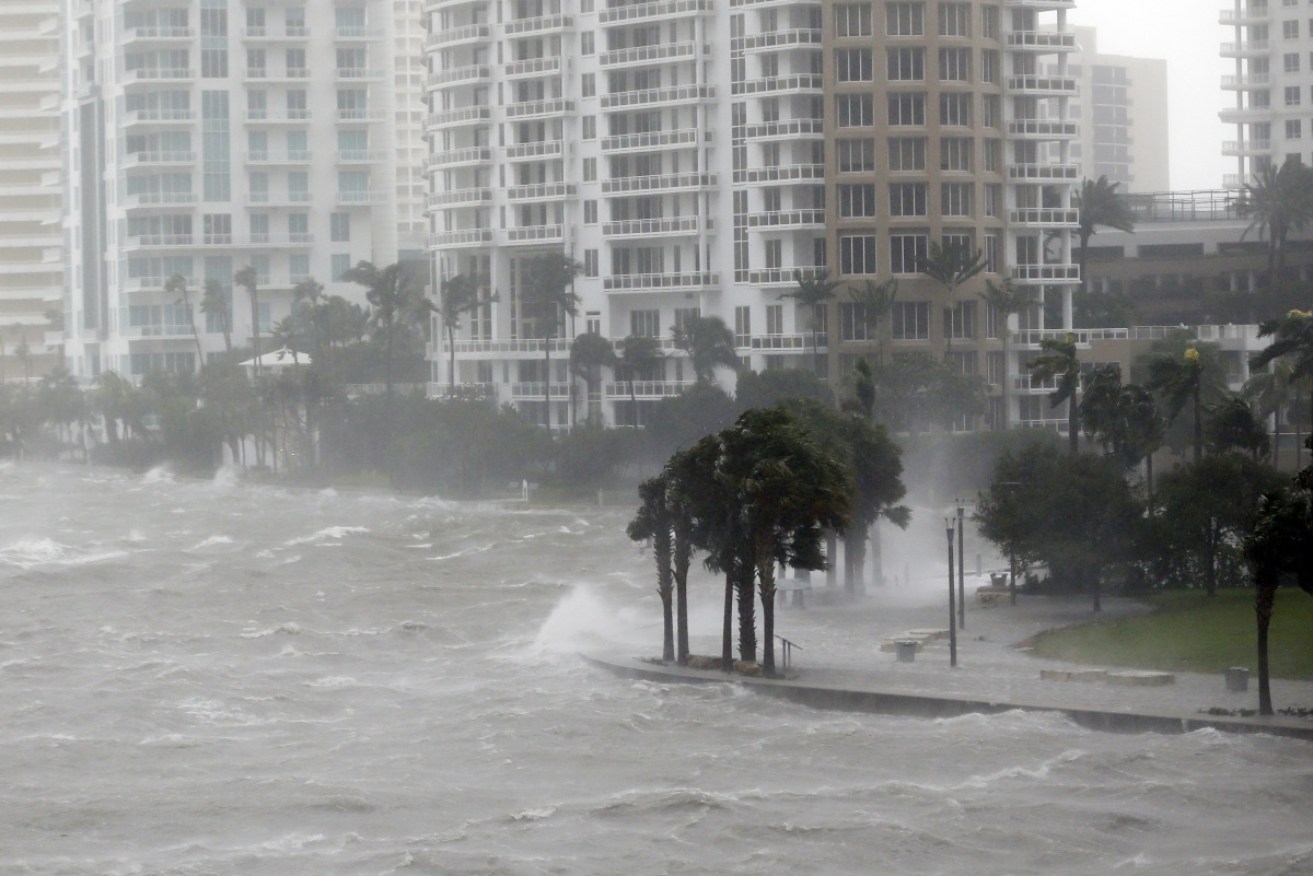Hurricane Irma: Central Miami streets turned to rivers with worse to come


Central Miami streets are under water with worst expected for the Florida west coast. Photo: AP
Hurricane Irma has knocked out power to nearly 4 million homes and businesses in Florida, threatening millions more as it creeps up the state’s west coast.
Irma hit Florida on Sunday morning as a dangerous Category 4 storm, the second highest level on the five-step Saffir-Simpson scale, but by afternoon as it barrelled up the west coast, it weakened to a Category 2 with maximum sustained winds of 177 kph.
Florida’s east coast was originally expected to bear the brunt of the storm, causing many people to seek refuge on the west coast – now in the face of the storm eye wall.
More than 8 million people in Florida and southern Georgia face hurricane-force winds, Ryan Maue of WeatherBell Analytics told CNN.
Water levels are rapidly rising in Naples, where water levels there have risen about 9 feet (3 metres), the National Hurricane Center (NHC) said.
“The threat of catastrophic storm surge flooding is highest along the southwest coast of Florida, where 10 to 15 feet of inundation above ground level is expected,” the NHC said.
“This is a life-threatening situation.”

Florida’s west coast is expected to bear the brunt of Irma. Photo: Getty
Georgia Governor Nathan Deal expanded a state of emergency to include all 159 of the state’s counties, while South Carolina Governor Henry McMaster issued a mandatory evacuation for some barrier islands.
Even before it came ashore on, Florida was feeling Hurricane Irma’s fury with at least three men killed, a woman forced to deliver her own baby and trees and apartment towers swaying in high winds.
The storm, which is now a category three, was one of the most powerful ever seen in the Atlantic and has already killed two dozen people in the Caribbean and pummelled Cuba with 11 metre waves.
Some 6.5 million people, about a third of Florida’s population, were ordered to evacuate the south of the state.
Officials warned that Hurricane Irma’s heavy storm surge – seawater driven on land by high winds – could bring floods of up to 4.6m along the state’s western Gulf Coast.
“You can’t survive these storm surges,” Florida Governor Rick Scott said.
Those who did not evacuate ahead of the storm are in danger, Federal Emergency Management Agency Administrator Brock Long said.
“You’re on your own until we can actually get in there and it’s safe,” he told CNN.
Flood waters submerged the highway that connects the isolated Florida Keys archipelago with the mainland and small whitecapped waves could be seen in flooded streets between Miami office towers.
The Scene In Downtown #Miami #HurrcaneIrma #Irma https://t.co/EqgSAbQq1D
— The Kerry Cartel (@KillarneyKnight) September 10, 2017
The Miami-Dade Police Department tweeted that its officers are sheltered for their safety and cannot respond to calls for help, warning residents, “DO NOT venture out!”
Miami Beach Police Major Richard Rand told BBC that flooding had reached as high as a metre inland, and many power lines were down.
One of the flooded areas was Miami’s financial district, Brickell, where Southeast 12th Street resembled a river, the Miami Herald reported.
Earlier a crane collapsed onto a building under construction in high winds.
President Donald Trump has called Hurricane Irma “some big monster” and said he wanted to go to the state very soon.
“The bad news is that this is some big monster,” President Trump told reporters at the White House on Monday morning (AEST), adding damage from the storm would be very costly.
“Right now, we are worried about lives, not cost,” he said after returning from Camp David, the presidential retreat in Maryland where he monitored the storm and met with his Cabinet.
The path of the storm, tracking the west coast of Florida, meant it might be less destructive than it would otherwise have been, Trump said, noting the next five or six hours would be critical.
“I hope there aren’t too many people in the path,” he said. “You don’t want to be in that path.”
Business In #Miami Surrounded by #Irma Floodwaters #HurricaneIrma #Florida — @WFLAJosh
pic.twitter.com/80VF4ZC3yx— €rnesto (@erveza) September 10, 2017
This is the the first year ever that the continental United States has been hit by two Category 4 hurricane landfalls in the same year.
Last month, Hurricane Harvey devastated much of coastal Texas, killing more than 70 people.
– With agencies








